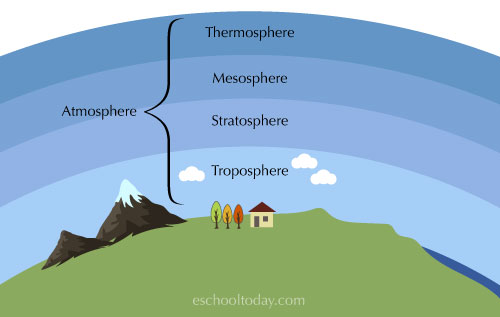- Earth System
The Atmosphere
The atmosphere is the gaseous component above the surface of the earth. This sphere is also a fluid sphere (the other fluid sphere is hydrosphere). The atmosphere is made up of gases and tiny water particles. The gases surrounding the earth are kept in place by the force of gravity.
The atmosphere is a mixture of gases: Nitrogen (78%) and Oxygen (21%), make up the most. There is also Argon, Carbon Dioxide and Aerosols (particles such as dust, pollen, ash, smoke). These gases are super important to life on earth because plants and animals depend on them to live.
The atmosphere is sustained by energy from the sun. When the sun shines, heat is radiated to the earth’s surface and reflected back into the atmosphere. The heat also warms the surface of the earth and causes evaporation, thereby sending moisture into the atmosphere. Thunderstorms, hurricanes, lightning and tornadoes are all processes of the atmosphere.
Layers of the atmosphere
Consider the illustration below:

The atmosphere comes in layers. The troposphere is the layer closest to the surface. It extends about 10km above sea level. Humans and plants live in this layer. Airplanes and birds also fly in this layer. As the layers go higher, the air becomes thinner. The other layers include the stratosphere (50km above sea level), mesosphere (85km above sea level), thermosphere (above 500km above sea level) and exosphere.
Beyond the exosphere is space.
